Recently, one of our hens started walking upright like a waddling penguin instead of the horizontal way chickens typically walk. I thought one of our chickens might have had something like this in the past; and so in this instance, I tried to do a little research on the Internet. I discovered that there is a condition called peritonitis, which in general is a swelling of the abdomen; and in chickens, it can be caused by a yolk missing the “funnel” (called the infundibulum) that “catches” them as they move from the ovary to the oviduct. They fall into the abdomen, which causes the peritonitis, and a build up of fluid in the area. Thus, the condition is called egg yoke peritonitis; and there are two kinds: sterile, where bacteria hasn’t developed in the swollen area, and the chicken still has an appetite and doesn’t die quickly; and septic, which is the opposite.
Besides our chicken not having a problem eating (which basically required that we lift food up to her), I examined her abdomen; and it was much like a water balloon; and so I suspected we had our diagnosis. Here are a couple of pictures showing her condition. At this point, she had one foot back and would sit on the other foot, and all she was able to do was slowly scoot around in a circle (we kept her isolated in our mini chicken tractor, to keep her from being picked on or hurt by the other chickens, which they will do to weak ones):
But then, with the problem identified, what to do about it. Some of the articles I read talked about draining the abdomen with a catheter, but that seemed pretty complex and involved. I did find a video though, which shows a person draining a chicken with peritonitis using just a needle.
It so happened that some friends of ours had just given us some large syringes and needles a few days before; and so, I decided to “operate.” The needle I chose to use was 1/2″ long and 1/16″ in outside diameter. Here is a photo summary of the procedure. I made very sure that everything, from the syringe, to the needle, to my hands, were as sterile as could be, including cleaning the syringe and wiping it with, bathing the needle in, and wiping my hands with rubbing alcohol.
Here I’m just getting her into position:
And then I flipped her onto her back:
I cut away the feathers around the area where I was planning to insert the needle:
And then I did so. I tried going at an angle parallel to the skin as much as possible to avoid puncturing her internal organs, but couldn’t seem to pull anything out with the syringe; so I found I needed to insert the needle at a steeper angle. Once I did, the fluid extracted pretty easily; and I was glad it was clear and didn’t have pus in it:
I pulled about 40ccs worth before stopping. One of the articles I read said to only pull half of the fluid out because the loss of too much could cause shock:
When we were done with the draining using the syringe, the hole continued to leak fluid; and over night, she lost quite a bit more. However, after it was all done, first, when I would pick her up, she was noticeably lighter than before; and second, she was able to bend over and eat and drink by herself somewhat, and was actually walking around. This went on for a few days, but her underbelly seemed to start to grow again. I decided to try the procedure again, and was able to pull out around 70cc. I tried going in again a couple more times, but couldn’t seem to find any more fluid — I tried keeping the needle at a flatter angle again, because there wasn’t nearly as much puffiness to her abdomen as before, and I believe I might not have been getting past the fat layer as it was basically impossible to extract anything out. However, I didn’t want to puncture any organs; and so I stopped; but it ended up that at least one of the needle holes continued to leak similarly to first time we drained her.
The next day she was doing much better, and was almost walking around like a normal chicken. Here is a video of her (the “other one [that] was only a still frame” that I mention refers to the fact that the “before” pictures were only still photos — the ones shown above):
A couple of days later, I took a pair of toe nail clippers and clipped the tip of her beak as it had started to grow past what looked to be normal as compared to the other chickens. My guess was that it had grown more since she hadn’t really been able to use her beak normally for some time.
I don’t know what will further happen with this situation, but it was neat to see her act like a chicken again and be able to “do chicken things.” It does seem that the liquid starts to collect in her abdomen again as the days go by, and perhaps we’ll have to continue to try draining it. However, we are thankful the Lord granted us this opportunity to learn about and care for the chickens, and that I didn’t apparently infect her myself when performing the procedure, nor poke her internal organs; and hopefully, if God is willing, she will once again become a productive member of the flock.
— David
(Please see our chicken peritonitis update for more information.)
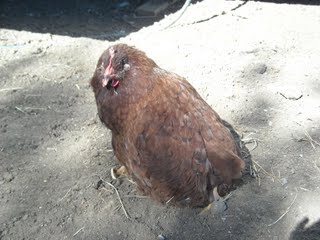
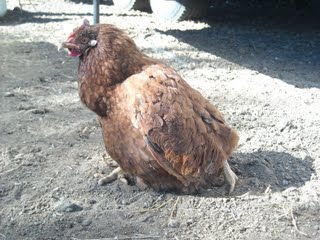
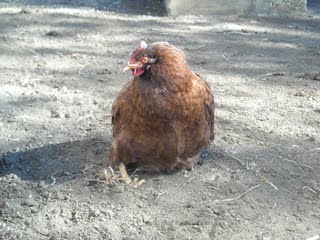
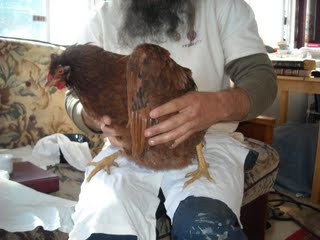
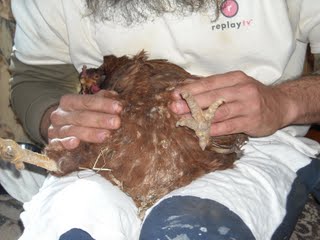
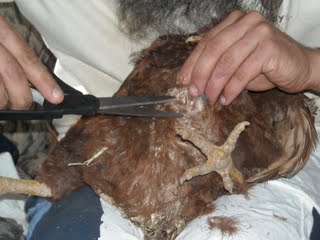
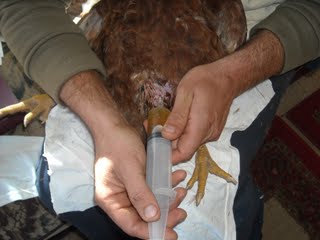
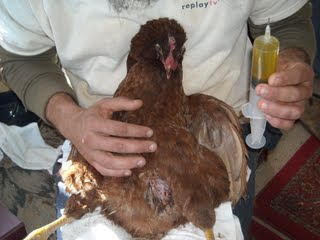
Wow, that is pretty wild – and amazing. Did the chicken make a fuss at all when you were "operating"?
I haven't been around chickens since I was a child, save our weekly visits to the farm, so I'd never seen a chicken stand up right like that.
What a blessing that you were able to at least help the situation (and the chicken) for the time being.
Blessings,
Shannon
Hi Shannon,
She wasn't too fond of being put on her back, nor of some of the follow-up procedures where the pressure on her abdomen wasn't as great, which made it harder to get the needle in.
Hopefully over time the situation in her abdomen will abate.
Anyway, thanks for saying hi.
— David
Hello Siffords:
I can't believe that you attempted this inside the house!
You will have to update us on her progress.
-the Irwins
This article blew my mind. I found this on accident looking for images on google. I don't own a farm nor do I know anything about chickens, yet I enjoyed this a lot! Very interesting and informational.
Not sure if the inflamation came back but I think you really did a good thing by giving her mobility back. If I was stuck on my back I'd risk life and limb to walk again. You did the right thing, good sir! Even if it is temporary.
Hello,
Well, only God is good; but we did try to help her. If you're interested, there is an update link at the bottom of this blog post regarding how things turned out with her.
Thanks for saying hello.
— David
Thanks for this post. We found it and will encourage our vet to complete the procedure. From Sydney, Australia.
Hi David,
Please do see the update link at the bottom of this post as eventually the hen died, although we're not vets either. 🙂 We have tried it one other time, and it worked for a while, but then she died too.
I'm not sure what we're missing or what we are doing wrong, or if the process in the end doesn't work that well.
Hope it does for you. If you're inclined, I'd be interested to hear how it goes and if there was anything special the vet did to make sure it worked.
Thanks!
— David
Hi David,
Thank you so much for posting this story as i currently have a chicken with this condition.
You have given me hope that we might be able to save her.
Thanks once again
Naomi
Hi Naomi,
Hopefully it will help. Please see the update blog post and the comments there as someone suggested there probably needs to be something done for the infection/potential infection part, like Baytril. I think if we have this situation again we'll plan to try angstrom silver as an antibiotic.
Hope it all works out well for you!
— David
I think the next step would be a Suprelorin implant, if the hen is a pet, which stops laying.
Hi Anonymous,
I guess that's a chip implant that puts out a hormone to temporarily stop the laying process. I suppose that's an option for someone just trying to save the chicken's life, especially because the prices I saw were 60 British pounds for the implant.
Thanks for the info.
— David
We drained one of our layer's abdomen last night, too. It was easy to do since her belly was like a water balloon. We used a 20 guage needle and 60 CC syringe which it attaches to. But she was so full that after the initial poke the water started streaming out around the needle and we just withdrew it and watched it flow. Probably 1 cup easily – likely more. She is much more comfortable now – if thinner. We think she'll eat more now that she can reach and her stomach is perhaps not as crowded by all the fluid.
I started this a few days ago – better finish. The needle poke enlarged a bit since there was so much fluid pressure. Although we bandaged it (as best we could) with a little antibiotic ointment, bandage came off and though she was in the garage, the flies found her and soon many baby maggots infested the site. We cleaned and peroxided and brought her into our laundry room. The site is closed up and healed now. She is comfortable but gradually weakening. Still eats/drinks well but walks limited amount and when taken outside hunts and pecks a bit but not terribly interested.
I did some research and water belly is usually indicative of liver or heart failure (if fluid clear.) Murky fluid could indicate cancer. Yellow fluid indicates EYP (egg yolk peritonitis) which is when the yolk accidentally ends up in the abdomen. Due to the genetic modification of layers – bred for even faster, constant egg production for a short period of time – they are contracting diseases at younger ages that you might expect in older hens. (Our girl is 2.5 years.) Although we gave her an antibiotic in her water for a few days, we don't expect it to help as the problem with excessive fluid is usually liver-disease related and not bacterial. Unless the Lord heals her miraculously, she will live as much as a few more weeks and then pass peacefully on.
Our youngest, who is 13, has been enjoying some cuddling time with Tweety-Belle (after some bottom cleaning each day) so that's been sweet to see. Normally we've found chickens to be similiar personalities by breed and easy to not get attached, but this one is now special to her 🙂
Thanks for posting the pictures and info. It helped! Hope these comments do, too. Next bunch of chicks we purchase are going to be as close to heritage as we can possibly find.
~ Barbara
Hi Barbara,
Thanks for all of the information! Glad the draining seems to at least have brought some relief, and hopefully she will pull through.
Thanks for taking the time to share and say hello!
— David
I have a hen that has this ….i give her diatomaceous earth (pure food grade ..not from feed store!) and a 1 standardized olive leaf capsule (20% oleuropein)mixed in moistened food . And a small bite of Nutri-cal paste every morning. She also seems to bloat when she gets chilly/cold. She does best when she is in temps of 68 degrees(F) or so.( yes as crazy as ppl think we are… she is in the house.) She has never passed an egg and the swelling comes and goes and we never drain it with needles etc. So far she has survived for 5 months…
Hi Shawna,
Thanks for taking the time to share that interesting information! Hope it continues to work out well!
— David
Hello All;
We have experienced Peritonitis in several forms, each presenting with ascites ( fluid). We have treated successfully with the following protocols. Remove affected bird from the flock. Isolate her in a clean dry, warm environment. Thoroughly, wash and dry with surgical prep soap, ( Betadine, Novalson or Hibiclens) rinse. Either aspirate with a 60cc syringe and 18 gauge needle or better yet, make a very small incision on the side of the rear ( the most swollen and non veinous area) and drain with gentle pressure. Remove aprox. 40 60% volume at the first session. Critically important that the hen is placed on general systemic broad spectrum antibiotic prior to and after the session. We have often used regular procaine penicillin IM a fairly strong dosage is in order about 1cc for a larger hen. Then after the drainage, lavage the incision (abdominal cavity) with Lactated ringers (sterile) and 10% penicillin. We use about 6-12 cc total volume. Then gently massage the area to move the introduced fluids. Drain again. Give the antibiotic IM and let the hen rest. In severely inflamed cases we will use a single dose of Banamine (0.01cc) to mitigate the inflammation and assist with inflammation in the lungs, secondary to the ascites. There is some duration of Peritonitis and based on the underlying causation, and aggressiveness of the treatment protocol will determine the outcome of the each case. We have never know and of the homeopathic remedies to be affective in purulent Peritonitis.
Hi Anonymous,
Thanks for taking the time to write out all that. By publishing this I won't personally vouch for it, but it seems like an interesting procedure.
Thanks again,
— David